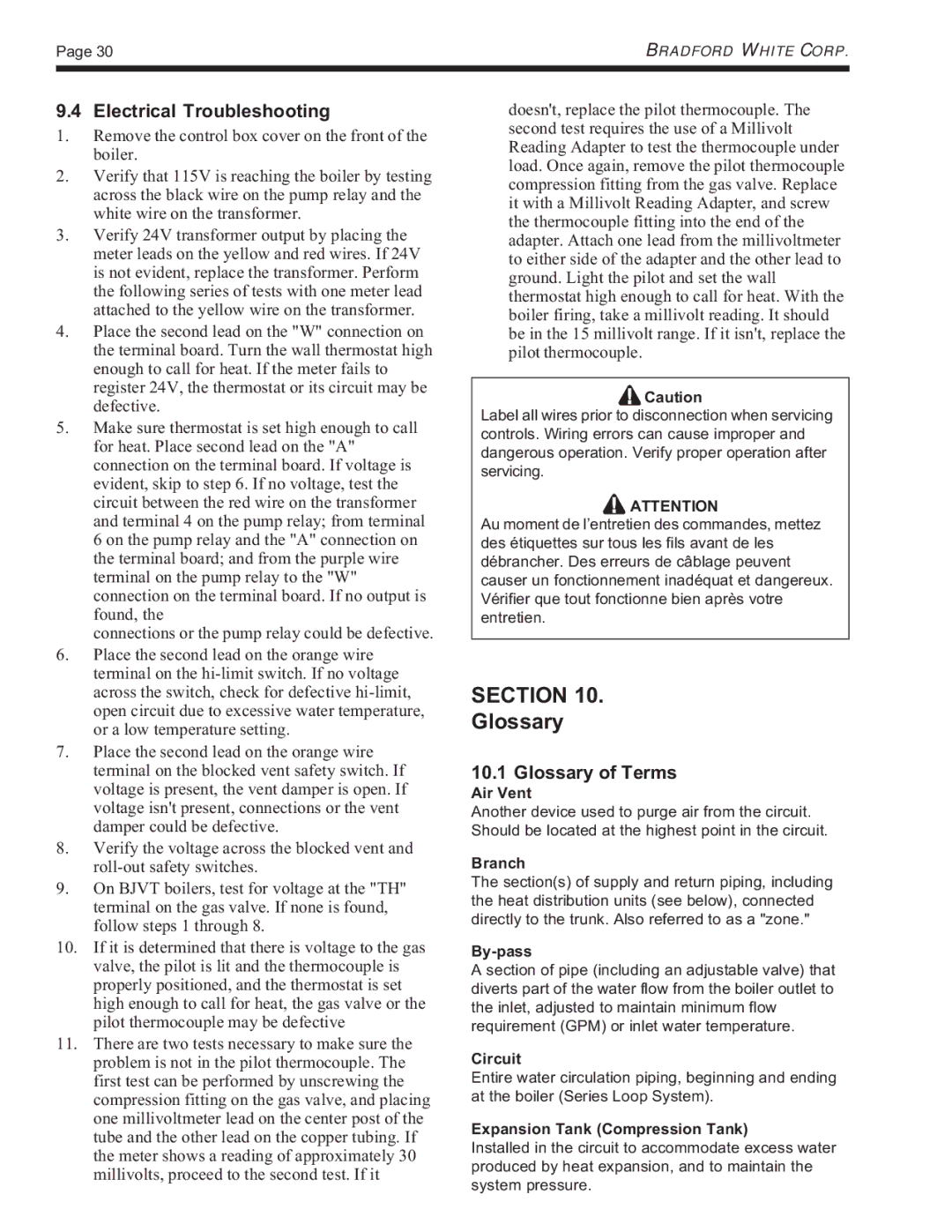
Page 30 | BRADFORD WHITE CORP. |
|
|
9.4 Electrical Troubleshooting
1.Remove the control box cover on the front of the boiler.
2.Verify that 115V is reaching the boiler by testing across the black wire on the pump relay and the white wire on the transformer.
3.Verify 24V transformer output by placing the meter leads on the yellow and red wires. If 24V is not evident, replace the transformer. Perform the following series of tests with one meter lead attached to the yellow wire on the transformer.
4.Place the second lead on the "W" connection on the terminal board. Turn the wall thermostat high enough to call for heat. If the meter fails to register 24V, the thermostat or its circuit may be defective.
5.Make sure thermostat is set high enough to call for heat. Place second lead on the "A" connection on the terminal board. If voltage is evident, skip to step 6. If no voltage, test the circuit between the red wire on the transformer and terminal 4 on the pump relay; from terminal 6 on the pump relay and the "A" connection on the terminal board; and from the purple wire terminal on the pump relay to the "W" connection on the terminal board. If no output is found, the
connections or the pump relay could be defective.
6.Place the second lead on the orange wire terminal on the
7.Place the second lead on the orange wire terminal on the blocked vent safety switch. If voltage is present, the vent damper is open. If voltage isn't present, connections or the vent damper could be defective.
8.Verify the voltage across the blocked vent and
9.On BJVT boilers, test for voltage at the "TH" terminal on the gas valve. If none is found, follow steps 1 through 8.
10.If it is determined that there is voltage to the gas valve, the pilot is lit and the thermocouple is properly positioned, and the thermostat is set high enough to call for heat, the gas valve or the pilot thermocouple may be defective
11.There are two tests necessary to make sure the problem is not in the pilot thermocouple. The first test can be performed by unscrewing the compression fitting on the gas valve, and placing one millivoltmeter lead on the center post of the tube and the other lead on the copper tubing. If the meter shows a reading of approximately 30 millivolts, proceed to the second test. If it
doesn't, replace the pilot thermocouple. The second test requires the use of a Millivolt Reading Adapter to test the thermocouple under load. Once again, remove the pilot thermocouple compression fitting from the gas valve. Replace it with a Millivolt Reading Adapter, and screw the thermocouple fitting into the end of the adapter. Attach one lead from the millivoltmeter to either side of the adapter and the other lead to ground. Light the pilot and set the wall thermostat high enough to call for heat. With the boiler firing, take a millivolt reading. It should be in the 15 millivolt range. If it isn't, replace the pilot thermocouple.
![]() Caution
Caution
Label all wires prior to disconnection when servicing controls. Wiring errors can cause improper and dangerous operation. Verify proper operation after servicing.
![]() ATTENTION
ATTENTION
Au moment de l’entretien des commandes, mettez des étiquettes sur tous les fils avant de les débrancher. Des erreurs de câblage peuvent causer un fonctionnement inadéquat et dangereux. Vérifier que tout fonctionne bien après votre entretien.
SECTION 10.
Glossary
10.1 Glossary of Terms
Air Vent
Another device used to purge air from the circuit. Should be located at the highest point in the circuit.
Branch
The section(s) of supply and return piping, including the heat distribution units (see below), connected directly to the trunk. Also referred to as a "zone."
By-pass
A section of pipe (including an adjustable valve) that diverts part of the water flow from the boiler outlet to the inlet, adjusted to maintain minimum flow requirement (GPM) or inlet water temperature.
Circuit
Entire water circulation piping, beginning and ending at the boiler (Series Loop System).
Expansion Tank (Compression Tank)
Installed in the circuit to accommodate excess water produced by heat expansion, and to maintain the system pressure.
